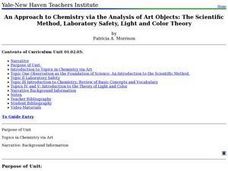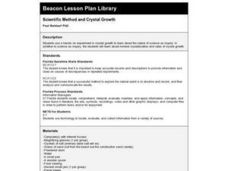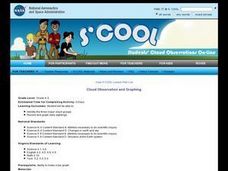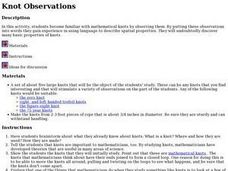Curated OER
Water Snails
Students study water snails. For this water snails lesson, students research the habitats of water snails. After conducting research, students investigate water snails in their habitats and generate scientific observations.
Curated OER
Scientific Method in Action
Students investigate the current environmental movement by cleaning up their own campus. In this environmental care activity, students practice cleaning their "environment" by picking up trash on their campus and decrease litter by...
Curated OER
How Are Soils Classified?
Students list the three texture groups that classify soils. They classify a soil sample as sandy, silty or clay soil.
Curated OER
Scientific Problem Solving
In this problem solving worksheet, students will conduct an experiment to answer this question: "How does watching too much television affect us?" Students will form a hypothesis, collect data, analyze their data, and draw a conclusion....
Curated OER
An Approach to Chemistry via the Analysis of Art Objects: The Scientific Method, Laboratory Safety, Light and Color Theory
Students create a painting that clearly exemplifies the use of primary pigments to make secondary pigments. They demonstrate the distinction between value and saturation. They explain the affect of adjacent colors on each other and...
Curated OER
Observing Lava Flows
Students examine the difference between fast and slow spreading lava flows. They identify various types of lava flow and determine the factors that cause them to form. Viewing photographs of lava flows, students working in groups,...
Curated OER
Beach Combing: Evidence of Life
Students comb the beach and gather remnants of unfamiliar life forms to make speculations about the origins of their discoveries. In this environments awareness lesson, students work in groups to search for evidence of life on the beach....
Curated OER
Scientific Method and Crystal Growth
Students conduct a hands-on experiment growing crystals to demonstrate the nature of science as inquiry. They discuss and test variables that affect crystal growth. They research mineral crystallization and mineral formation on the...
Curated OER
Food & Science - How Healthy is Your Diet?
Learners experiment with various foods to determine fat and starch content. They rub jam, peanut butter, bananas, and other foods in a small circle on a piece of paper, and observe the results. If there is a high fat content in the...
Curated OER
A Tale of Two Wetlands
Students observe 2 separate wetlands (following downloadable worksheets) and record 10 similarities and 10 differences between them. Then they present their recommendations to the class who roleplay the government's wetland conservation...
Curated OER
How to Keep a Scientific Journal
Young scholars record observations of a living organism over a period of time. They observe meal worms and record their observations in a scientific journal.
Curated OER
You Light Up My Life: Developing a Scientific Theory for What Fuels a Candle's Flame!
Young scholars examine how candles work and how scientific theories are developed and tested. Students propose hypotheses about what is burning in a candle then perform tests in order to develop their scientific theory. After a teacher...
Curated OER
Apply Technological Design and Scientific Habits of Mind
Students work together to brainstorm their obstacles in testing different scientific principles. In groups, they are given a scenerio with a specific dilemma and they use the internet to research how to solve the problem. They design a...
Curated OER
Using Adjectives to Describe Observations
Seventh graders write observations of organisms based on both audio and video sources. They describe organisms which they view using appropriate adjectives.
Curated OER
Piece of the Sky: Introduction for Making S'COOL Observations
Learners observe and discuss cloud cover. They identify percent of cloud cover, calculate cloud cover by fraction and convert to a percent, and compare their models with the current real sky cloud cover.
Curated OER
Cloud Observation and Graphing
Students identify the three major cloud groups. They are introduced to the three main cloud types and spend a week making and recording observations of clouds. Students produce a graph that presents their findings and conduct research...
Curated OER
Using the Scientific Method to Determine Which Conditions Best Favor Plant Growth
Seventh graders examine how the environment can affect biological processes. They identify the best conditions for the germination of bean seeds. They record and analyze their data. They write about their observations in an essay.
Curated OER
Rocky Observations
Students examine two images of rocks, make their own observations of individual rocks through drawing, and explain how the same observation skills can be used in the study of geology.
Curated OER
Monet's Japanese Bridge -A Scientific Journal
Fourth graders design a bridge and answer critical questions about scientific inquiry and enterprise in a Science journal.
Curated OER
Snail Observation Exercise
Learners are given a pond snail in a clear glass and asked to make observations on the snail's form and behavior. One of the key ideas is that seemly common subjects (like snails) often have surprising or interesting properties.
Curated OER
Math: Knot Observations
Students discover the importance of knots to mathematicians in developing scientific theories. In small groups, they examine knots and make obeservations about them. Students discuss the ways to distinguish knots and make lists of...
Curated OER
Observation and Discovery
Students explore the basic skills guiding sound scientific invvestigation and methodology. They are introduced to a powerful scientific tool-the microscope. Students review the parts of the microscope. They discuss the inventor of the...
Curated OER
My Science Journal
For this scientific method worksheet, students complete a ten page science journal that could be used for any investigation. Included are pages for question, hypothesis, materials, procedure, observations, data, diagram and conclusion....
Curated OER
How High Can You Fly?
Students learn the four concepts of flight; drag, lift, thrust, and weight. In this scientific inquiry lesson, students participate in a flight activity where they jump as high as they can to stamp a large sheet of paper and measure and...

























